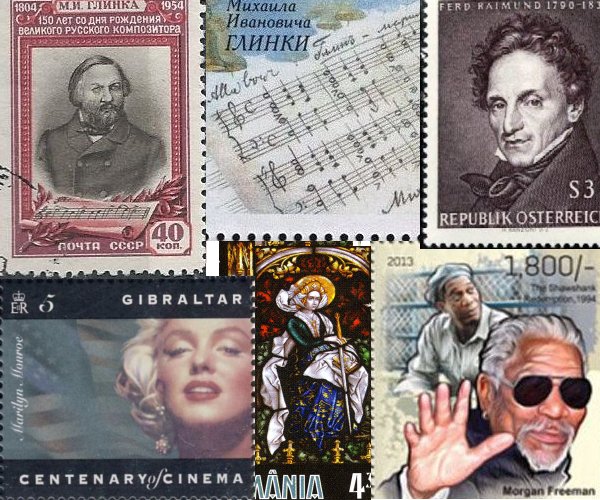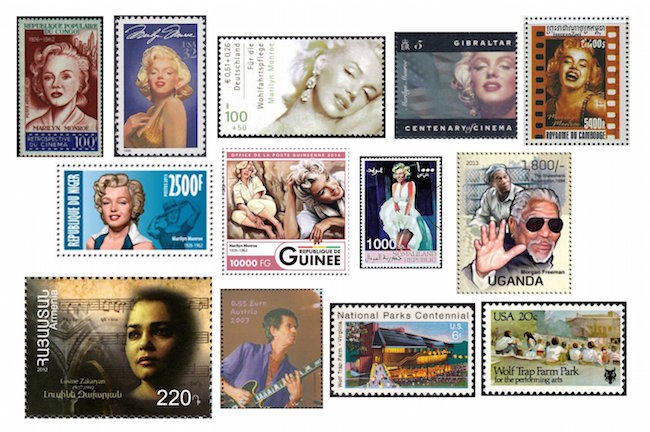The Arts on the Stamps of the World — June 1
An Arts Fuse regular feature: the arts on stamps of the world.

By Doug Briscoe
Russia issued two pairs of stamps for Mikhail Glinka (1 June [O.S. May 20] 1804 – 15 February 1857), one in 1954 for the sesquicentennial of his birth (upper left in the first collage) and another pair just three years later for the centenary of his death (upper right). Then in 2004 for the bicentenary came a handsome group of three stamps plus one label. Besides the portrait stamps, the other pictorials represent: from 1954, a scene from his opera Ivan Susanin (soo-SAHN-yin); from 1957, a group portrait of Glinka being visited by the poets Pushkin and Zhukovsky; and from 2004, a label showing a page from one of his scores (can anyone identify this music?), another scene from Ivan Susanin, and one from his most popular opera Ruslan and Ludmila. (The group portrait of Glinka, Pushkin, and Zhukovsky was not contemporary. I was not able to learn much about it online. It seems the artist was—is?—one Viktor Evgenievich Artamonov, born in 1919.) The other Glinka stamps I have are from Bulgaria and Romania.

I find no stamp for Italian writer and polymath Francesco Scipione, marchese di Maffei (1675 – 11 February 1755), but a school in Verona named for him has its philatelic monument. A good enough excuse for me to write about this extraordinary man. The noble Maffei family came from Bologna, though Francesco was born in Verona. He became a member of the Academy of Arts in Rome when he was 23 and developed an interest in drama. He made his name as a playwright with the tragedy Merope, considered his masterpiece, in 1714. His other interests included old manuscripts and archaeology and, in later life, astronomy and physics. He wrote about Etruscan antiquities, founded a museum, and built an observatory. He wrote philosophical treatises on divine grace and against the existence of magic and witches. There is also an article he wrote about the new keyboard instrument (the piano) invented by Bartolomeo Cristofori. Along the way he also fought in the War of the Spanish Succession and edited a literary magazine. Why in heaven’s name had I never heard of this man before?
Józef Elsner (1769 – 18 April 1854) was the young Chopin’s piano teacher. He wrote 8 symphonies, at least 18 operas, and many masses and other sacred works.

Austria has seen fit to issue no fewer than three stamps in honor of actor and comic dramatist Ferdinand Raimund (1 June 1790 – 5 September 1836). (On the third one he is seen portraying his creation The Millionaire Peasant.) His mother died when he was twelve, his father when he was fourteen, and Ferdinand had to give up school and earn his living as a baker’s assistant. Customers included the people at the Vienna National Theater (later the Burgtheater), so he was thus introduced at an impressionable age to the magic of backstage goings-on. Soon enough he was treading the boards himself. He wrote his eight plays in the years 1823-34. Classical music mavens may be interested to know that Conradin Kreutzer wrote incidental music for the last one, Der Verschwender (The Spendthrift). Raimund came to a sad end. With an exaggerated fear of rabies, he shot himself in reaction to a dog bite (the animal was not rabid) and died a week later. His portrait used to be on the old Austrian 50 schilling banknote. There is a Raimund Theater in Vienna.
A glassmaker and the son of a glassmaker, Gustav van Treeck (1854 – 12 January 1930) established his own glassworks in Munich in 1888. In 1903 he was named glassmaker for the Royal Bavarian Court. He made stained galss windows for many churches, not only in Germany and Switzerland, but also in the United States, and won gold medals for his work in Chicago and Barcelona. The glassworks he founded still exists in Munich today. The stamps show examples of his work that are today housed in Bucharest’s Western Old Art Museum, founded in 1946.
Along with Elvis, Marilyn Monroe (born Norma Jeane Mortenson; June 1, 1926 – August 5, 1962) is one of the most popular topics for stamps around the world, so popular, indeed, that many of them have been issued by no-nonsense postal services for actual use on real, honest-to-goodness envelopes to be, you know, actually processed through the postal system, that is to say, mailed. (Not that high sales numbers weren’t a consideration.) I was surprised to find that the People’s Republic of Congo had issued a Marilyn Monroe stamp as early as 1971! (As a side note, one of the other stamps in that set of four honors the “French Marilyn Monroe”, Martine Carol, whose birthday we also celebrated within the last month.) The US issued one in 1995, and the other “legit” stamps—from Germany, Gibraltar, and Cambodia (!)—were all released in the present century. I show also a few of the prettier examples from Niger, Guinea, and the unrecognized Somaliland Republic.

The nation of Uganda issued a block of stamps honoring African-American entertainers just four years ago, one of them being the eminent (and decidedly philatelically deserving) Morgan Freeman, to whom we wish a happy 80th birthday and many happy returns.
Armenian soprano Lusine (née Svetlana) Zakaryan (1937 – December 30, 1992), though born and reared in Georgia, moved in her teens to Yerevan and remained active in Armenia in opera, folksong, and church music until her early death from diabetes at the age of 55.
Rolling Stones guitarist Ronnie Wood (born 1 June 1947), a member of the band since 1975, can be seen on a 2003 issue from Austria, the upper right stamp in a block of four devoted to the Stones. Wood also attended Ealing Art College and has made many paintings and drawings, including the cover for Eric Clapton’s Crossroads album. Tomorrow, by the way, is the birthday of Rolling Stones drummer Charlie Watts, and we’ll see his stamp from the Austrian block then.
The inaugural concert to be held at Wolf Trap Farm Park (now Wolf Trap National Park for the Performing Arts) took place on this date 46 years ago. The land had been donated in 1966 by Filene’s department store heiress Catherine Filene Shouse, a Boston-born Wheaton College grad. Music had been performed there as early as 1969, but that official opening concert on June 1, 1971featured Van Cliburn, Norman Treigle, and the National Symphony Orchestra under Julius Rudel, with others including the United States Marine Band. Wolf Trap is the only U.S. National Park devoted to the arts.
Alas, no stamp yet for English Poet Laureate John Masefield (1 June 1878 – 12 May 1967). Happy birthday to two distinguished actors from the British Isles, the Scotsman Brian Cox (born 1946) and the Welshman Jonathan Pryce (1947).
A graduate of the University of Massachusetts with a B.A. in English, Doug Briscoe worked in Boston classical music radio, at WCRB, WGBH, and WBUR, for about 25 years, beginning in 1977. He has the curious distinction of having succeeded Robert J. Lurtsema twice, first as host of WGBH’s weekday morning classical music program in 1993, then as host of the weekend program when Robert J.’s health failed in 2000. Doug also wrote liner notes for several of the late Gunther Schuller’s GM Recordings releases as well as program notes for the Boston Classical Orchestra. For the past few years he’s been posting a Facebook “blog” of classical music on stamps of the world, which has now been expanded to encompass all the arts for The Arts Fuse.
